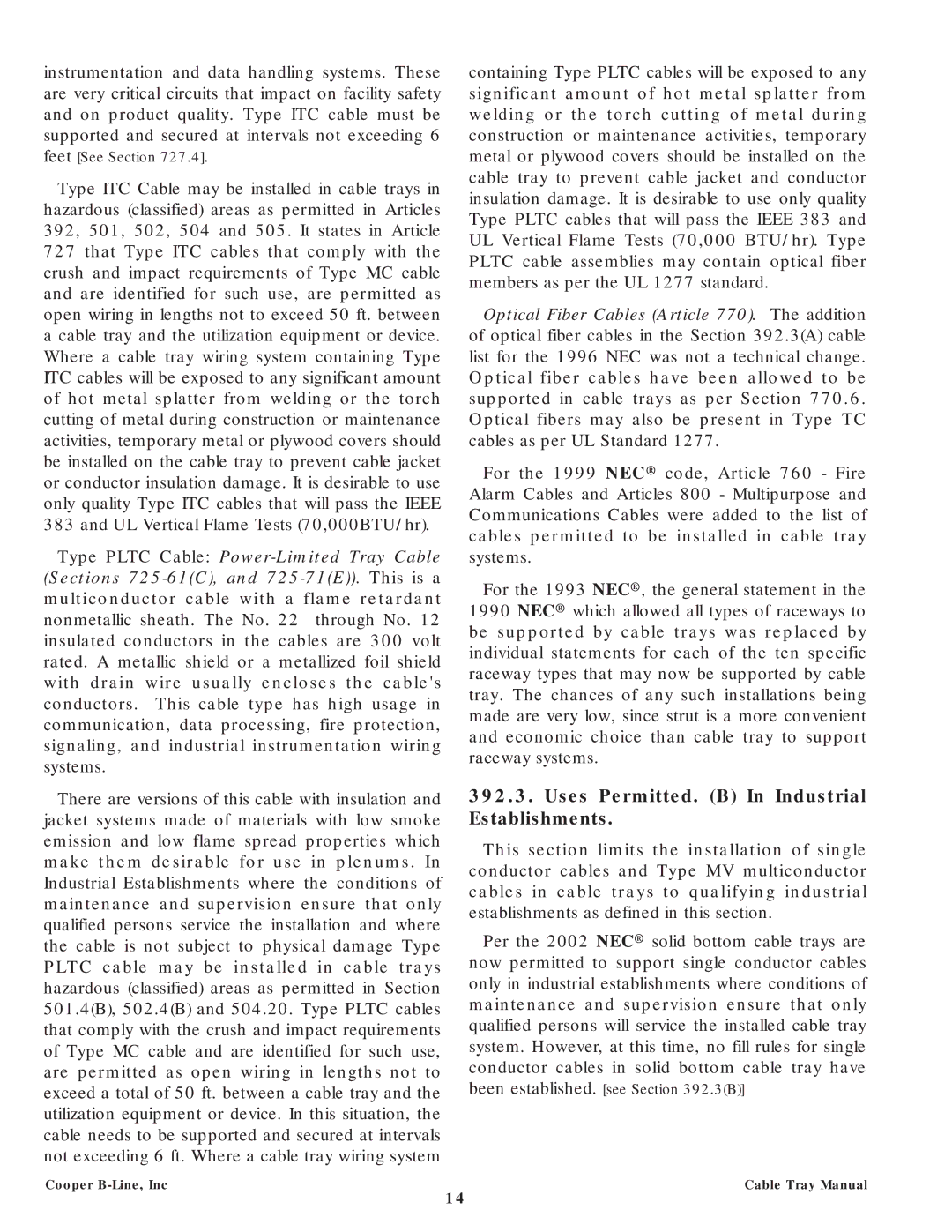instrumentation and data handling systems. These are very critical circuits that impact on facility safety and on product quality. Type ITC cable must be supported and secured at intervals not exceeding 6 feet [See Section 727.4].
Type ITC Cable may be installed in cable trays in hazardous (classified) areas as permitted in Articles 392, 501, 502, 504 and 505. It states in Article 727 that Type ITC cables that comply with the crush and impact requirements of Type MC cable and are identified for such use, are permitted as open wiring in lengths not to exceed 50 ft. between a cable tray and the utilization equipment or device. Where a cable tray wiring system containing Type ITC cables will be exposed to any significant amount of hot metal splatter from welding or the torch cutting of metal during construction or maintenance activities, temporary metal or plywood covers should be installed on the cable tray to prevent cable jacket or conductor insulation damage. It is desirable to use only quality Type ITC cables that will pass the IEEE 383 and UL Vertical Flame Tests (70,000BTU/hr).
Type PLTC Cable:
There are versions of this cable with insulation and jacket systems made of materials with low smoke emission and low flame spread properties which make them desirable for use in plenums. In Industrial Establishments where the conditions of maintenance and supervision ensure that only qualified persons service the installation and where the cable is not subject to physical damage Type PLTC cable may be installed in cable trays hazardous (classified) areas as permitted in Section 501.4(B), 502.4(B) and 504.20. Type PLTC cables that comply with the crush and impact requirements of Type MC cable and are identified for such use, are permitted as open wiring in lengths not to exceed a total of 50 ft. between a cable tray and the utilization equipment or device. In this situation, the cable needs to be supported and secured at intervals not exceeding 6 ft. Where a cable tray wiring system
Cooper B-Line, Inc
containing Type PLTC cables will be exposed to any significant amount of hot metal splatter from welding or the torch cutting of metal during construction or maintenance activities, temporary metal or plywood covers should be installed on the cable tray to prevent cable jacket and conductor insulation damage. It is desirable to use only quality Type PLTC cables that will pass the IEEE 383 and UL Vertical Flame Tests (70,000 BTU/hr). Type PLTC cable assemblies may contain optical fiber members as per the UL 1277 standard.
Optical Fiber Cables (Article 770). The addition of optical fiber cables in the Section 392.3(A) cable list for the 1996 NEC was not a technical change. Optical fiber cables have been allowed to be supported in cable trays as per Section 770.6. Optical fibers may also be present in Type TC cables as per UL Standard 1277.
For the 1999 NEC® code, Article 760 - Fire Alarm Cables and Articles 800 - Multipurpose and Communications Cables were added to the list of cables permitted to be installed in cable tray systems.
For the 1993 NEC®, the general statement in the 1990 NEC® which allowed all types of raceways to be supported by cable trays was replaced by individual statements for each of the ten specific raceway types that may now be supported by cable tray. The chances of any such installations being made are very low, since strut is a more convenient and economic choice than cable tray to support raceway systems.
392.3.Uses Permitted. (B) In Industrial Establishments.
This section limits the installation of single conductor cables and Type MV multiconductor cables in cable trays to qualifying industrial establishments as defined in this section.
Per the 2002 NEC® solid bottom cable trays are now permitted to support single conductor cables only in industrial establishments where conditions of maintenance and supervision ensure that only qualified persons will service the installed cable tray system. However, at this time, no fill rules for single conductor cables in solid bottom cable tray have been established.
Cable Tray Manual
14
